Lone Hansen met up with Diane Walker, a photographer and painter from Port Townsend. Diane encountered Lone when she had Art Soup, a gallery on Bainbridge Island. Diane, a photographer at the time, did a show with her. Lone vividly remembers that when Diane came in to discuss her exhibit, she suggested they paint a certain wall blue. “Well, that just didn’t sit well with me because I wanted white walls for showing the art. And at that time I’d never done it any other way,” said Lone. Today, when she looks back, she thinks Diane was right and she’s since told her so.
Here are excerpts from Lone Hansen’s extensive conversation with artist, Diane Walker. Some wording and order has been revised to provide further clarity.
Lone Hansen: How are you surviving being an artist during the pandemic?
Diane Walker: I’m doing great, but have a closet full of art! At the beginning of the pandemic I decided that the best way to stave off the fear was to use this as a time to explore new painting techniques. So, every single day I spent two hours in the studio. At the end of every studio time I had a new painting. Some of them I painted over because they were so terrible, but it was a wonderful time to explore. I’m discovering more of what I like and what I want to paint.
Hansen: How have you handled the isolation?
Walker: My husband and I are both introverts so isolation suits us just fine.
Hansen: You feel you have enough to do?
Walker: I’m in the middle of painting a bunch of small paintings for two different shows that have asked for work and I don’t like working smalls. So painting hasn’t really been satisfying. I found a place in New York called Green Buffalo Productions and they send out playwriting prompts every two weeks. You get three props you have to use; three possible settings and you choose one; and three lines of dialogues and you choose one; and you write a ten-minute play. So, [I’ve been] writing 10-minute plays!
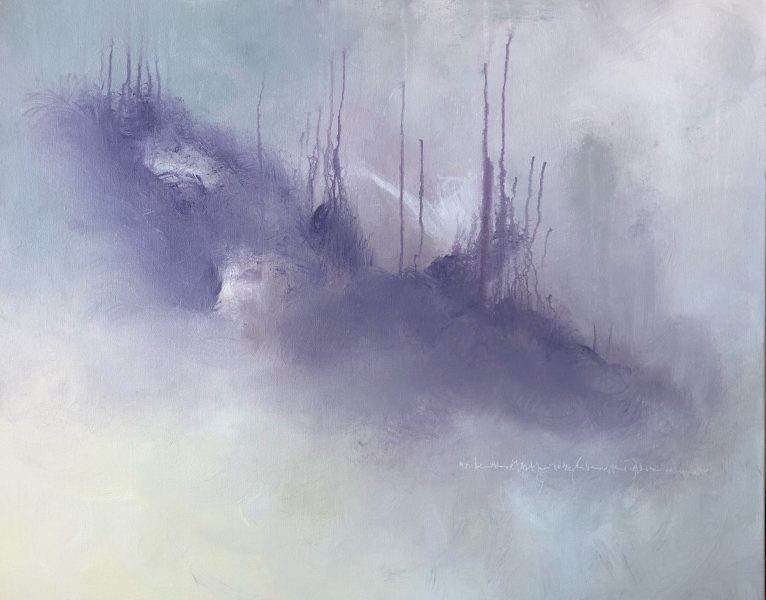
Hansen: Are you connected with any gallery?
Walker: This is my second year with Northwind in Port Townsend. I’m part of the artist showcase. This means that I have art on [display] there year round, which is such a change from how things are done on Bainbridge Island.
Hansen: Was it difficult to break into the art scene on Bainbridge? Did you have fellow artists to share ideas with?
Walker: I moved to Bainbridge Island in July of 2001 from Orcas Island. On Orcas I had a group of seven women artists and we got together once a month for dinner, laughter, jokes, stories, but also art. We could talk about the thing we were working on, where we were going with it, what we were exploring, and we’d show each other our stuff. I kept looking for that – the whole 20 years I was on Bainbridge.
Hansen: Did you find anyone?
Walker: The two people I found I could really talk to about art were Gillian Bull and Vicky Harrison. So when Vicky moved to Port Townsend there was this gap in my life. One of the lovely things about Vicky is that she and I have a very similar aesthetic. That’s how we met – our daughters were friends and I went to pick up my daughter and she was at Vicky’s studio. I realized the paintings she was doing looked a lot like the photographs I was taking. Even though both of us have shifted direction since those days, we both ‘live in the same space.’ Right now that’s an abstract space.
I adore Gillian and I love taking classes from her. I think of her as a very close friend but she doesn’t like abstract… doesn’t get it. I have all her stuff but I couldn’t really come to her with the kinds of questions that I want to ask.
Hansen: Why do you think it was difficult to find these fellow artists? I have now found that in Diane Haddon. She’s so generous…and I need it.
Walker: There tends to be a lot of competition in art. It’s like theatre (I’m also involved in theatre) and people get a little protective of their secrets and their special ways of doing things. And so, it’s hard to find somebody like Vicky who’s willing to share everything.
Hansen: When you lived on Bainbridge did you try and put together a group of artists?
Walker: I gave up at a certain point. I moved a lot as a child, so every three and a half years I was in a different school. One of the things I learned from that is to be very careful when I enter a new community and not to make any assumptions. So Orcas worked out the way it did because the woman who started that group was my postmaster on Shaw Island, when I was living there. So she invited me into the group. On Bainbridge I was waiting for the invitation that never came! And that is true on all levels on Bainbridge.
Hansen: Is that your experience in Port Townsend?
Walker: Here it’s so different! We’ve been invited everywhere — to be a part of things. I’m already the secretary of the Port Ludlow artist group. And people are so welcoming here. Maybe because it’s smaller, because it’s less competitive, a less entitled [area], I don’t know what the difference is, but…
Hansen: What do you think it is?
Walker: There was always [this feeling] of, ‘I’m not enough’ — if I could figure out what ‘enough’ was. I feel so much more comfortable here. Most of the people I know who’ve been here or lived here have nothing but positive things to say about it. I have another friend on Bainbridge from my theatre experiences – Linda Owens. On the weekends she and I would spend a day on Port Townsend. It’s been our treat for years now, so to finally live here is wonderful.
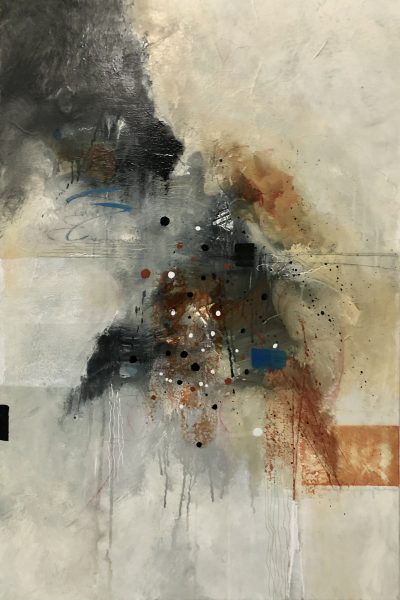
Hansen: How have you connected with artists over the pandemic?
Walker: I discovered other artists on Instagram. That’s been fabulous. My current fascination is with things that are sort of poured. I don’t mean pouring like goopy pouring where all the colors are mixed together. There’s a little bit of blue here, and faded green here, and some drops. I want to know what they’re using – is that ink, is that acrylic, is that water color? Are they doing it on paper or canvas – and they don’t tell you any of those things.
Hansen: Can you ask?
Walker: Most of the people I really like are not in this country – they’re Danish, or German, or Brazilian, and so I just watch and hope.
Hansen: What do you see when you look back – in terms of your art?
Walker: I loved art as a little kid — my mother was an artist. My earliest memory is being in kindergarten and we were given a picture of a bee that we were supposed to color in. I finished coloring it in and flipped the paper onto the other side and traced it over and started coloring in. The teacher called my mother in and told her this was unacceptable.
Hansen: Unacceptable?
Walker: Unacceptable. So that’s kindergarten. After 2nd grade I basically stopped doing art and I don’t remember doing [it] after that. So, fast forward many years, after my divorce, I ended up working for this marketing and high tech company. I started designing logos for them and really got into graphic design, Pagemaker, Photoshop, etc. Then I got the job at the Diocese of Olympia and I redesigned the logo, the letterhead on the newspaper, and that’s when I got my first camera.
Hansen: Why did you need a camera?
Walker: I took the job as director of communications. After the editor quit the first day on the job, I had the responsibility of producing a monthly newspaper and the next issue was due out in one week. I had to rename the newspaper, redesign the logo, and produce something! Because I had to take pictures for the newspaper I took a little class and I discovered I really loved the camera.
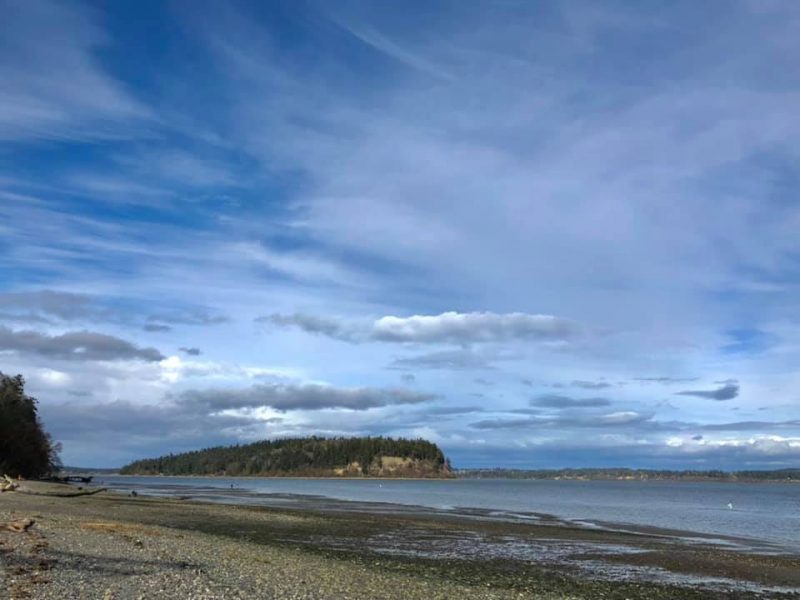
Hansen: That’s when you began your career as a photographer?
Walker: When I left the Diocese and moved to Shaw Island I bought myself a copy of, “The Artist’s Way” by Julia Cameron and she said to take yourself on art dates. So I bought myself a similar camera to the one I used at the Diocese. I’d go down to the beach and take pictures of driftwood. And that was the beginning of my photography career. Bill Gates’ parents lived across the street from our little cabin on Shaw Island and I rode the ferry with his stepmom one time. I was going through all my pictures because I had to get them developed in Anacortes. She said, ‘Those are wonderful! You should put those in a gallery. You should try the one on Friday Harbor.’ So I went to that gallery and they said, ‘Yes.’ I went to the Lopez Gallery and they said, ‘Yes,’ and suddenly I was a photographer! I did that for years.
Hansen: And that’s how I met you.
Walker: You were my first gallery on Bainbridge Island.
Hansen: Where did you show after that?
Walker: Because Bainbridge Arts & Crafts (BAC) takes 50% of everything, and they liked my stuff getting larger, that meant I couldn’t just get standard, cheap frames to put [my photograph] in. I had to frame it. Eventually there was no way I could make money as a photographer. So I tried presenting in other ways — printing on fabric, printing on aluminum. They objected to everything. I thought, ‘I’m never going to make money.’ Not that I needed to make money, but I wanted to at least pay for [supplies] and photography is an expensive proposition anyway.
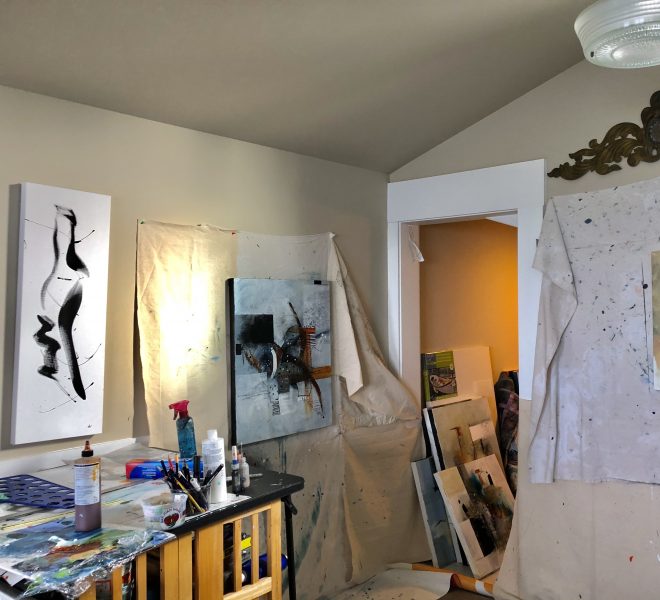
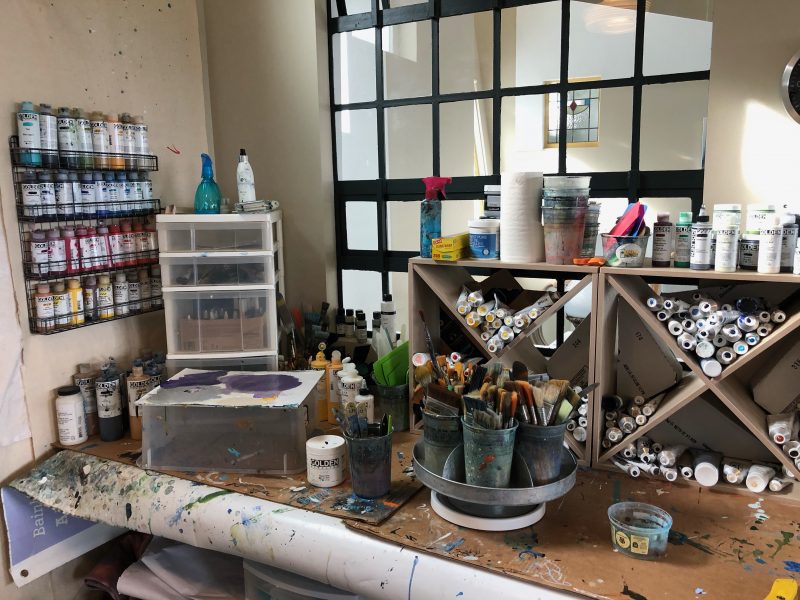
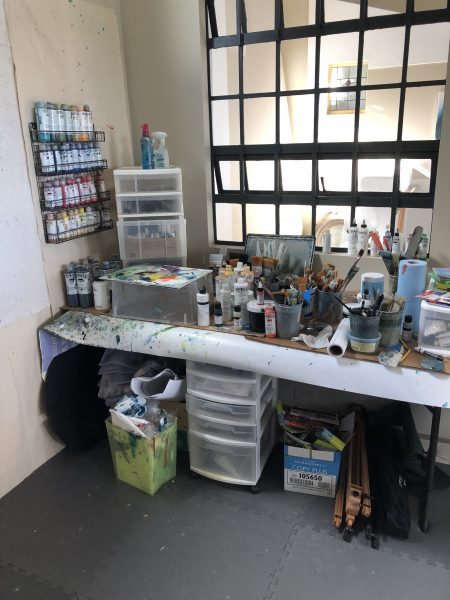
Hansen: Did you give up at that point?
Walker: I was at a show and Christopher Mathews’s work was hanging behind what used to be the old sales counter before the remodel. It was this wonderful abstract that also looked like a beach. And I thought, ‘Wow, wow, that’s fabulous!’ He was giving a demo the following weekend. He came in with a canvas that was 4×6 and he set up one of those 6 foot tables with these huge bins of paint and he had giant spatulas and brushes and he just slapped paint on that thing. It looked like so much fun I thought, ‘I want to do that!’ I took a class with him and discovered that he starts every painting with a drawing — usually from a photograph that he has. I’m not comfortable drawing. Right away that was a challenge. After the two classes I ended up in tears. At the end of the second class he said, ‘You know, you might be better off working on your own for a while.’ So I haven’t taken a class since. I spend all my time in the studio, exploring.
Hansen: How dependent are you on selling your art?
Walker: I’m not, thank God, because I haven’t sold one piece since COVID started and I think that’s a miracle. There’s a piece of me that wonders if I should actually have a website. I thought briefly about getting on Saatchi.com. There are so many artists on there and you’re basically invisible. I got involved with the Port Ludlow art people and am hoping to stay at Northwind. I’m hoping to get involved in the merger with Northwind and the Port Townsend School of Arts at some level. Occasionally I submit stuff online.
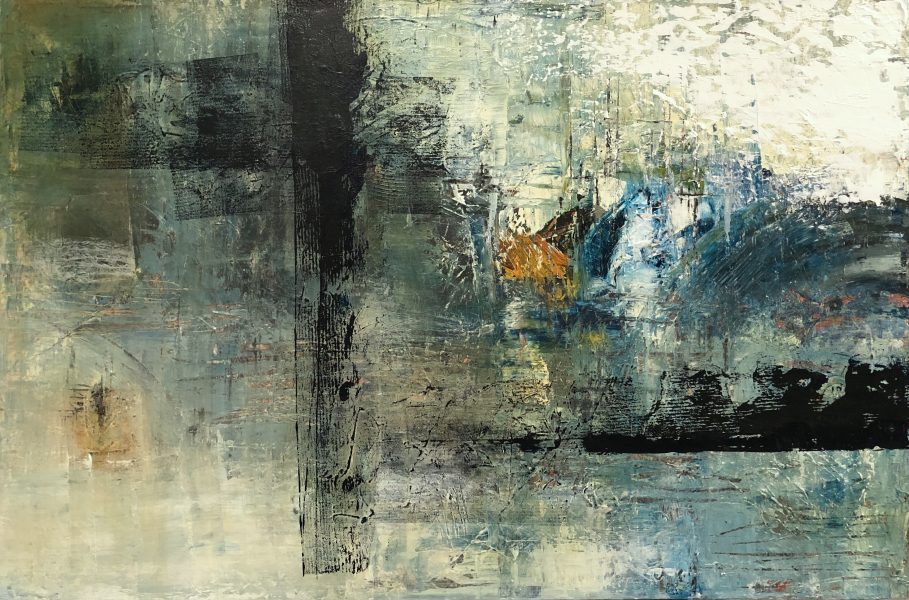
Hansen: Have you sold your work?
Walker: I made it into the Anacortes Art Show and it was bought by the Skagit Valley Hospital. I do meditate every morning and I’ve done a lot of shows in hospitals. I feel really good about that. When we first bought this house I had 20 pieces hanging here in town. Because I tend to paint large, that works well in hospitals. They’re very contemplative-feeling, with soothing colors. Northwind had a large collection of my stuff and they just kind of threw it at the hospital and it was wonderful. It was really fun to walk through the hospital and see my own work hanging on the walls and think, ‘Somebody’s feeling a little better about whatever horrible thing is happening to them because they’re looking at my painting.’ So that matters.
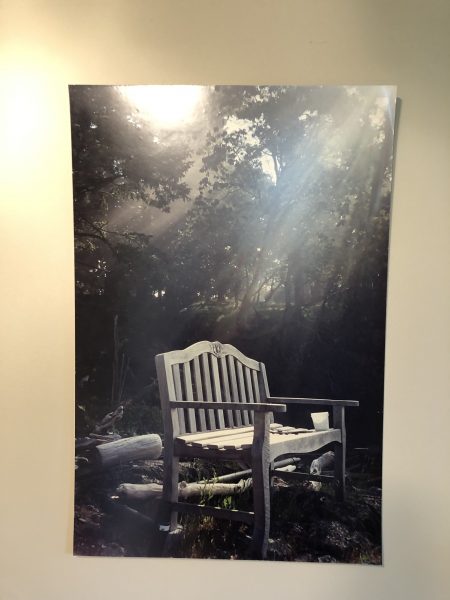
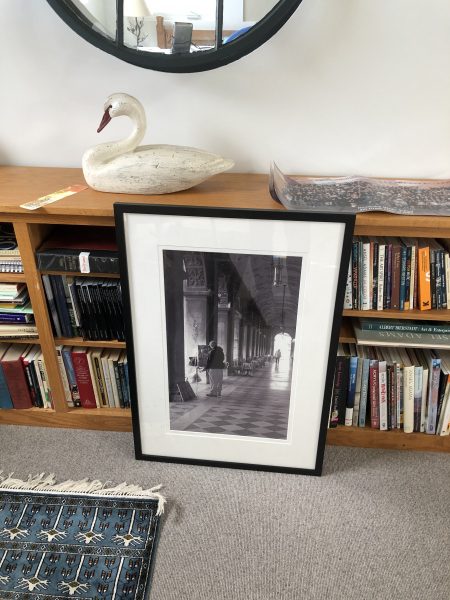
Hansen: Looking ahead, what do you see?
Walker: What I long for is to figure out which of all the different kinds of art I produce are the ‘most me.’ And to really delve into that. I remember there was a black and white show at BAC they were planning. I was with a friend, who’s a black and white photographer. David Sessions said, ‘You don’t do black and white photography.’ ‘Oh yes, she does,’ said my friend.
Hansen: Did they invite you into the show?
Walker: They invited me into the show. I had a bunch of shots from Venice. At that point I was known for boats. ‘People would be surprised that I have these shots with no boats and water.’ David said, ‘Oh no, I would know a Diane Walker anywhere.’
Hansen: That made you pause…
Walker: I thought, OK what’s that about. It’s not just the blues and teals, which are another characteristic of my work. If it’s a black and white and you can still tell ‘it’s a Diane Walker,’ what does that mean? So I eventually figured out that it’s the contemplative part of my work that shows up in the final product. So that launched me on a whole new career – ‘contemplative photography.’ And I launched a whole new website – contemplativephotography.com. I would like for something like that to happen with my painting but I’m not there yet. I don’t know what it will be.
Hansen: What’s the best way to reach you?
Walker: 206.790.9934 or dwalkerarts@gmail.com
OTHER ARTICLES BY LONE:
How Artists are Surviving the Pandemic: Diana Cronin
How Artists are Surviving this Pandemic: Victoria Foster Harrison
How Artists are Surviving this Pandemic: Sue Skelly
How Artists are Surviving this Pandemic: Judy Sorrels
How Artists are Surviving this Pandemic: Steve Parmelee
How Artists are Surviving this Pandemic: Diane Haddon
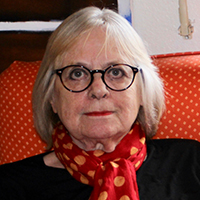
ABOUT LONE HANSEN. Lone is an artist who has owned several galleries in San Francisco, Seattle, and Bainbridge Island. She currently lives in Poulsbo where she is a member of the Poulsbo Arts League. During this pandemic and through her interactions with fellow artists, Lone has been creating art, gaining daily inspiration, cooking, and is taking care of dogs again. “I like this new normal,” she said. “It’s good for me – it is.” Lone has been “downsizing” her entire life – not just her studio, but her “whole life.” “It’s good to remember a life well lived,” she reflected. “Never boring, and it’s got me to where I am today.”